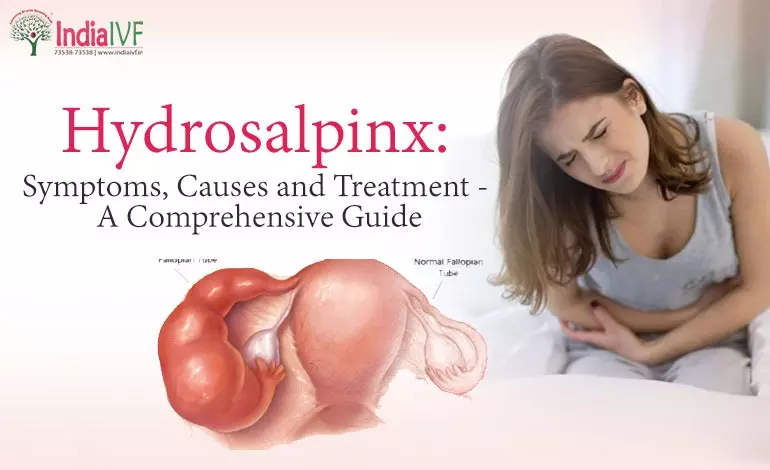Your cart is currently empty!



Every woman’s journey to motherhood is unique, with distinct twists and turns. Sometimes, unanticipated roadblocks may appear, such as Hydrosalpinx. But don’t let that fancy medical term intimidate you. Here, at India IVF Fertility, we believe in equipping our patients with the knowledge necessary to navigate their paths to parenthood confidently.
So, let’s pull back the curtain on Hydrosalpinx, dissecting its symptoms, causes, and treatment strategies. Remember, knowledge is power, and in this case, it could be the key to unlocking your dreams of parenthood.
Hydrosalpinx, derived from the Greek words ‘hydro’ meaning water and ‘salpinx’ meaning tube, is a condition affecting a woman’s fallopian tubes. When a blockage causes fluid to fill and expand the tubes, we refer to it as Hydrosalpinx. This condition can lead to discomfort, and more importantly, it can hamper a woman’s fertility, making it a significant concern for couples trying to conceive.
Often, Hydrosalpinx can play the stealthy villain, causing no observable symptoms until one bumps into fertility problems. However, in some cases, the following symptoms might tip you off:
Hydrosalpinx isn’t just a tongue twister; it’s a potential dream shatterer for aspiring mothers. When the fallopian tubes are filled with fluid, it can prevent the egg from traveling down the tubes and meeting the sperm, resulting in infertility. Furthermore, it can also increase the risk of ectopic pregnancy, a potentially dangerous condition where the egg implants outside the uterus, typically in the fallopian tubes.
Hydrosalpinx usually stems from an infection in the tubes, often due to sexually transmitted infections (STIs), pelvic inflammatory disease (PID), or following a ruptured appendix. Other causes can include abdominal surgeries, endometriosis, or certain types of cancer treatments.
A diagnosis of Hydrosalpinx can be confirmed through:
A detailed account of your medical history, focusing on any previous pelvic or abdominal surgeries, infections, or episodes of severe abdominal pain can guide the physician towards the likelihood of Hydrosalpinx.
Ultrasonography and Hysterosalpingography are effective imaging techniques that can identify any fluid accumulation or blockage in the fallopian tubes.
In some cases, a laparoscopy may be performed. This minimally invasive surgical procedure provides a direct visual of the pelvic organs, allowing the surgeon to detect any anomalies such as a hydrosalpinx.
Mild cases of Hydrosalpinx without any symptoms may only require close observation. Regular follow-ups are necessary to monitor any changes in condition.
Including a balanced diet, regular exercise, maintaining a healthy weight, and staying away from smoking and excessive alcohol can bolster overall health and improve fertility.
In severe cases, surgical treatment may be required. Procedures like salpingostomy or salpingectomy, aimed at draining the fluid or removing the affected tube, respectively, may be recommended.
Preventing Hydrosalpinx primarily involves safeguarding pelvic health:
Regular gynecological check-ups and screenings for sexually transmitted infections can help catch potential problems early.
Use of condoms and regular testing for STIs can significantly reduce the risk of developing Hydrosalpinx.
Early detection and treatment of pelvic inflammatory disease or other infections can prevent potential complications like Hydrosalpinx.
Although it’s rare, yes, a Hydrosalpinx can rupture, leading to a condition called ‘hydrosalpinx rupture’. This can cause severe abdominal pain and requires immediate medical attention.
Recognizing the signs of a hydrosalpinx rupture can be crucial for timely intervention:
Hydrosalpinx itself does not lead to cancer. However, in rare cases, hydrosalpinx might be a result of gynecologic cancer, which emphasizes the importance of a thorough medical examination.
In some rare cases, mild Hydrosalpinx might resolve without intervention. But it’s usually a persistent condition requiring medical attention. Never ignore persistent abdominal pain or irregular periods. When in doubt, always consult with your doctor or fertility expert.
Hydrosalpinx can be an intimidating hurdle in your journey to parenthood, but armed with knowledge and the right medical team by your side, you can confidently navigate your way through. Remember, every challenge is an opportunity for us to become stronger, and overcoming Hydrosalpinx might just make your victory of motherhood even more special.
Symptoms can include lower abdominal pain or discomfort, unusual vaginal discharge, pain during intercourse, irregular menstrual cycles, and unexpected weight loss or gain.
Yes, Hydrosalpinx can cause infertility as the fluid-filled tubes can prevent the egg from meeting the sperm.
Hydrosalpinx usually stems from an infection in the tubes, often due to sexually transmitted infections, pelvic inflammatory disease, or following a ruptured appendix.
Hydrosalpinx can be diagnosed using medical history, imaging techniques like ultrasonography, or through surgical procedures like laparoscopy.
Treatment options can range from conservative management and lifestyle changes to surgical interventions, depending on the severity.
Yes, although rare, Hydrosalpinx can rupture and this condition requires immediate medical attention.
Symptoms include intense abdominal pain, vomiting or nausea, fever, and dizziness or fainting.
Hydrosalpinx itself does not lead to cancer. However, in rare cases, it might be a result of gynecologic cancer.
While rare, mild Hydrosalpinx might resolve without intervention. However, it's usually a persistent condition requiring medical attention.
Regular gynecological check-ups, practicing safe sex, and prompt treatment of infections can prevent potential complications like Hydrosalpinx.
At India IVF Clinics we provide the most comprehensive range of services to cover all the requirements at a Fertility clinic including in-house lab, consultations & treatments.